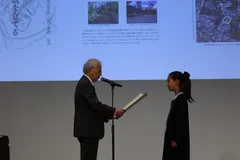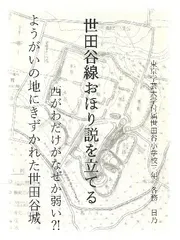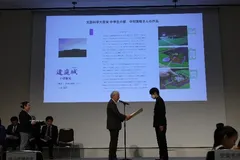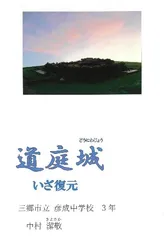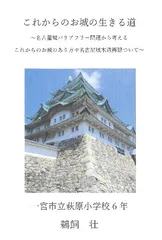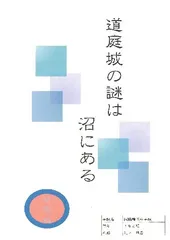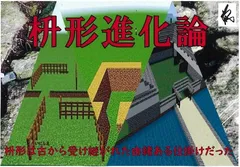Japan's Largest Research Contest on Castles for Elementary and Junior High School Students Winners of the 22nd Free Research Contest on Castles
公益財団法人日本城郭協会
The Japan Castle Research Association (President: Tetsuo Owada), in cooperation with One Publishing Co. The judging panel, chaired by Rifumi Kato, Director of the Association, selected the following winners: Hino Kagami (3rd grade, Setagaya Elementary School attached to Tokyo Gakugei University / Tokyo) and Kiyotaka Nakamura (3rd grade, Hikonari Junior High School attached to Sango City / Saitama Prefecture) received the Minister of Education, Culture, Sports, Science and Technology Award, and Takeshi Ukai (6th grade, Ichinomiya Hagiwara Elementary School / Aichi Prefecture) and Harune Adachi (1st grade, Dokkyo Saitama Junior High School / Saitama Prefecture) received the Japan Castle Society Award. One Publishing Award: Kaisei Tonobayashi (Tagajo Municipal Tagajo Elementary School, 6th grade / Miyagi Prefecture) and Harune Adachi (who also won the Japan Castle Society Award). The following 10 elementary school students and 12 junior high school students were selected to receive the Excellence Award and Honorable Mention Awards.
The award ceremony was held on December 17 at the "Castle Expo 2023" held at Pacifico Yokohama.
The names of the works and reasons for receiving the awards are as follows.
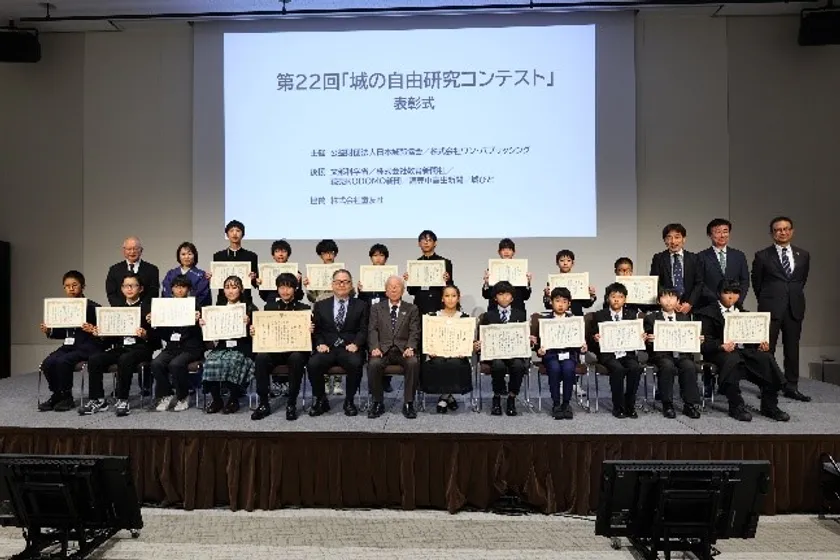
Commemorative photo of the award ceremony at the venue of the Castle Expo
The Minister of Education, Culture, Sports, Science and Technology Award (Elementary School Division)
<Hino Kagami (Tokyo Gakugei University Setagaya Elementary School, 3rd grade / Tokyo, Japan)
Setagaya Castle, which was built on the site of the Yogaii
Why is only the west side weak? Formulating the Setagaya Line Ohori Theory
The process of formulating a hypothesis from a simple question, examining topographic maps, shading and undulation maps, and old photographs, conducting field surveys, and trying to prove the hypothesis by multifaceted methods such as field experiments using PET bottles was highly evaluated as excellent. The writing was also excellent, drawing me in as I read. It is a wonderful work that shows how much research can be done on the ruins of a lost castle.

Minister of Education, Culture, Sports, Science and Technology Award
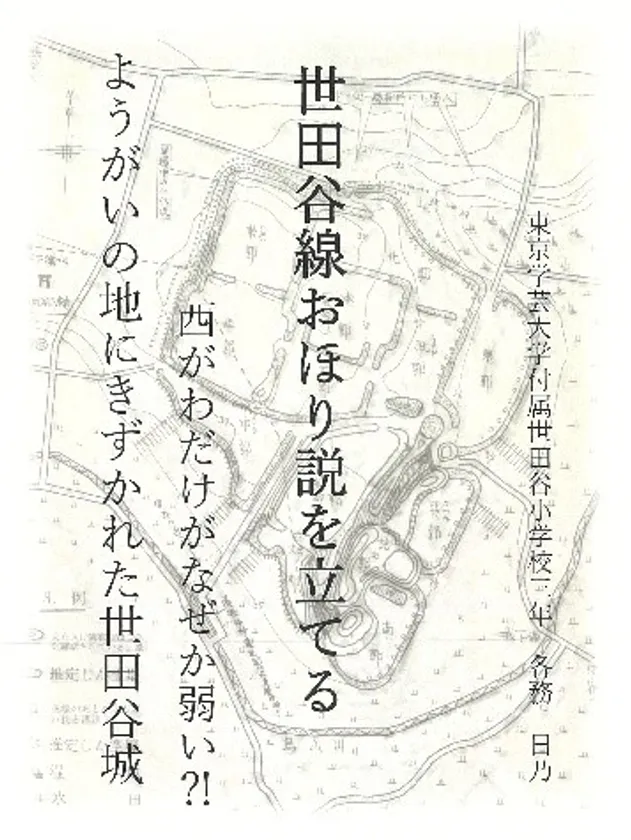
Mr. Kagami's work
The Minister of Education, Culture, Sports, Science and Technology Award (Junior High School Student Division)
<Mr. Kiyotaka Nakamura (3rd year student at Misato City Hikonari Junior High School / Saitama Prefecture)
Restoration of Douniwa Castle
In order to verify his hypothesis that his great-grandfather's "Handa Village" was originally "Douniwa Village," he was able to identify the location of the castle through reading topographical maps and excavation data since the Meiji era and through field research. The project has been successfully brought to a conclusion by restoring Douniwa Castle as a square building and passing it on to future generations. The fact that he made a concrete model of the castle was also an object of his evaluation.
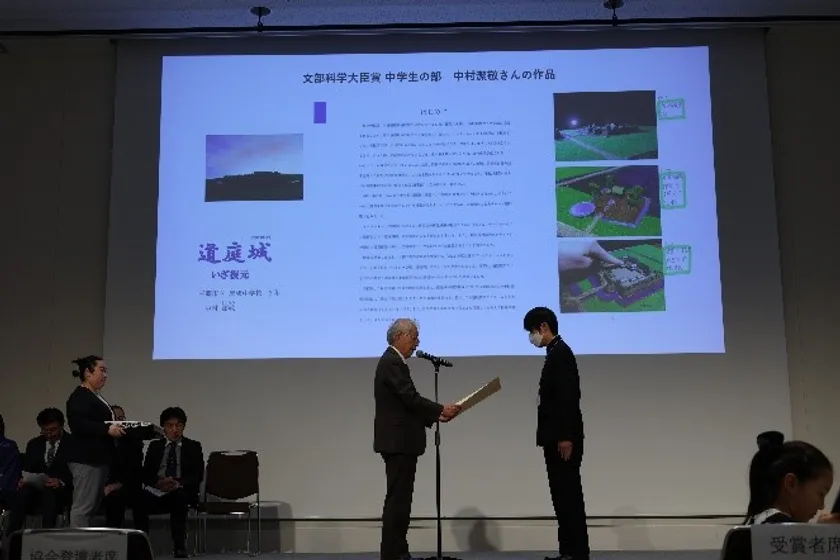
Minister of Education, Culture, Sports, Science and Technology Award

Mr. Nakamura's work
The Japan Castle Society Award (Elementary School Division)
<Mr. Takeshi Ukai (Ichinomiya City Hagiwara Elementary School, 6th grade / Aichi Prefecture)
The way of life of castles in the future - Thinking about the barrier-free issue of Nagoya Castle
The future of castles and the wooden reconstruction of Nagoya Castle.
This extremely difficult issue was thoroughly analyzed from all angles, and was deepened through on-site coverage of five other castles, including Matsumoto Castle. The choice of sites was also excellent: the existing castle keep, the wooden reconstructed castle keep, the RC reconstructed castle keep, and the castle with only stonewalls, adding depth to the work by considering the entire castle, not just the wooden reconstruction.
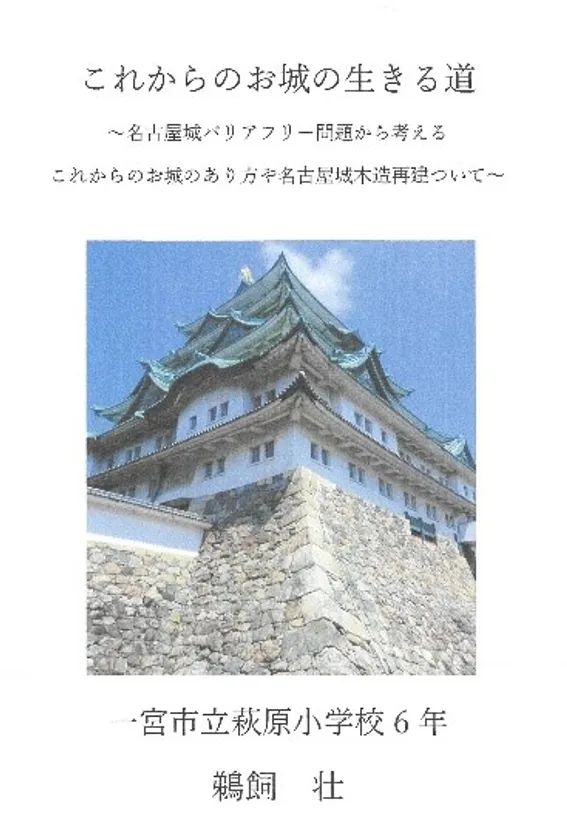
Mr. Ukai's work
Japan Castle Society Award / One Publishing Award (Junior High School Division)
<Harune Adachi (1st year student at Dokkyo Saitama Junior High School / Saitama Prefecture)
The mystery of Douniwa Castle lies in the swamp.
The work was very close to that of Ms. Nakamura's, and after much deliberation by the judges, we gave it a special double award. This is a continuation of the research that has been conducted since elementary school, and once again, the research has been very carefully and thoroughly supported. The process of realizing the importance of the strategic location of water and land transportation based on the difference in topography between a river and a road, connecting this with the vast amount of data obtained through previous research, and concluding with reference to the relationship between the Sobataka Shrine and influential clans was excellent.
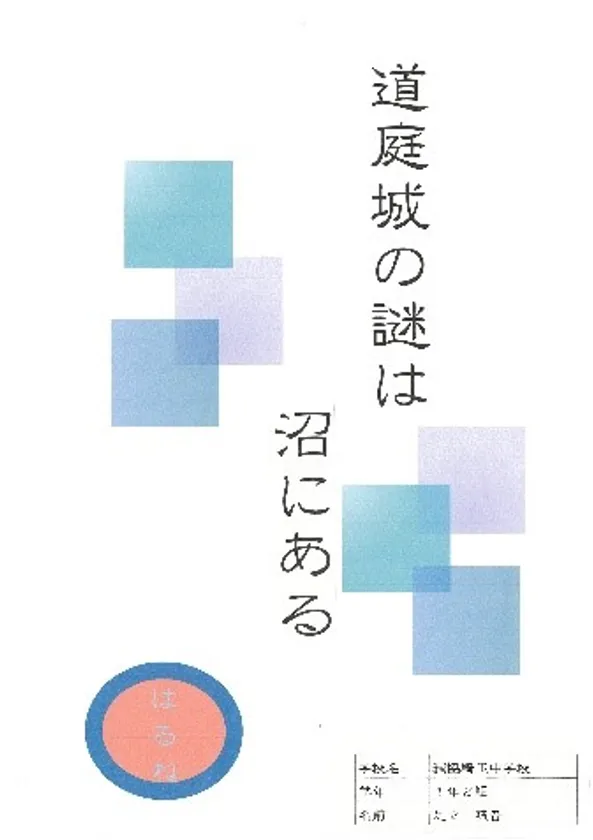
Mr. Adachi's work
One Publishing Award (Elementary School Section)
<Kaisei Sotobayashi (Tagajo Municipal Tagajo Elementary School 6th grade / Miyagi Prefecture)
Masugata Evolution Theory" - Masugata was a venerable device inherited from ancient times.
The author made his own hypothesis about Masugata, tracing it back to the enclosure settlements that began at the Yoshinokaseri ruins in the Yayoi period, and conducted field surveys at 17 locations. The model using Minecraft was also very effective, and the way the paper was put together was very good.
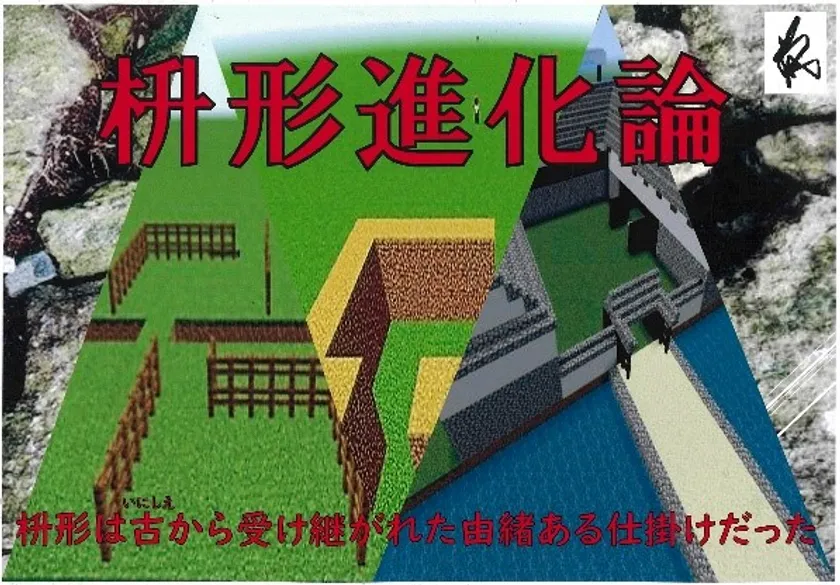
Mr. Tonobayashi's work
The Excellence Award and Honorable Mention Award winners are as follows
■Elementary School Student Section
Excellence Award: Kosuke Ino (2nd grader, University of Tsukuba Hearing Special Needs School / Chiba, Japan)
First free research: A castle related to Ieyasu
Excellence Award Taichi Hasegawa (Ono City Obe Elementary School 5th grade / Hyogo Prefecture)
Ikeda Terumasa and Himeji Castle
Excellence Award Ryota Suzuki (5th grader, Musashino City Senkawa Elementary School / Tokyo)
Where is the "castle place name"?
Excellence Award Mizusho Nakagawa (Haki Elementary School 6th grade / Fukuoka, Japan)
A discussion on the defense plan of Akizuki Castle (camp)
Honorable Mention: Tadashi Ogawa (3rd grader, Otori Elementary School, Yokohama / Kanagawa Prefecture)
What would I do?
~Thinking about the Hojo clan's way of defense based on the battle of Yamanaka Castle~.
Honorable Mention: Taime Kato (5th grader, Nagoya City Gokuraku Elementary School / Aichi Prefecture)
Which castle is the strongest castle in the siege? ~The Mystery of the Hirayama Castle~!
Honorable Mention: Rinto Warisaya (5th grader, Nonohama Elementary School, Fukuyama / Hiroshima Prefecture)
The mystery of Fukuyama Castle and the existing castle tower
Junior High School Student Division
Excellence Award Tomoya Uchida (1st grader at Fujimatsu Junior High School in Kariya City / Aichi Prefecture)
Stone wall structure to be preserved for the future
Excellence Award Mitsutasa Nakawaki (Kakegawa City Nishi Junior High School 2nd grader / Shizuoka Prefecture)
Reading and explaining from old documents
The True Figure of Kakegawa Castle III: Another Kakegawa Castle Hidden in History
Excellence Award Takuo Ito (Komaba Toho Junior High School 3rd grader / Tokyo, Japan)
Castles in Kanto and Koshin - Common and different aspects of their development
Honorable Mention: Aishin Shimizu (Shimada Junior High School attached to the Faculty of Education, Shizuoka University / Shizuoka, Japan)
The change of the time represented by the word "castle
Honorable Mention: Yuki Kawakami (Okayama Misakiyama Junior High School, Okayama, Japan)
Castle in the Sky: The Mystery of Bitchu Matsuyama Castle
~Through the comparison with the castles of Ukita Naoya and Hideie in Bizen
Honorable Mention: Yusho Sato (Utsunomiya University Junior High School, 2nd year student / Tochigi Prefecture)
1700 Years of Utsunomiya History: The Utsunomiya Clan and Utsunomiya Castle, the Strongest in the Northern Kanto Region
Honorable Mention: Junki Kobayashi, Rintaro Kameyama, Shunma Suzuki
(Shimada Junior High School attached to the Faculty of Education, Shizuoka University / Shizuoka Prefecture)
The relationship between guns and the "circle": Suwabara Castle, Tanaka Castle, and Sanadamaru
Honorable Mention: Sousuke Shinomiya (3rd grader, Shimada Junior High School attached to the Faculty of Education, Shizuoka University / Shizuoka Prefecture)
Is the Takeda style of castle building really the Takeda style? ~Marumade, the keystone of Suwabara Castle
◆Outline of the "Free Research Contest on Castles
Name of the event: "The 22nd Free Research Contest on Castles
Sponsor: The Japan Castle Research Association / One Publishing Co.
Supported by: Ministry of Education, Culture, Sports, Science and Technology, Kyoiku Shimbun, Yomiuri KODOMO Newspaper, Yomiuri Chugakusei Shimbun, Joubito
Sponsor :Doyusha
Objective: To promote the comprehensive learning of elementary and junior high school students by allowing them to visit and study castles, which are symbols of their local communities.
To deepen understanding of Japan's cultural heritage through research, investigation, and presentation.
To deepen their understanding of Japan's cultural heritage through research, investigation, and presentation.
Summary :This year's contest will be held to select the best works of free research on castles submitted by elementary and junior high school students from all over the country.
The Minister of Education, Culture, Sports, Science and Technology Award and the Japan Castle Prize will be awarded to the best works submitted by elementary and junior high school students from all over Japan.
The Minister of Education, Culture, Sports, Science and Technology Award, the Japan Castle Association Award, and the One Publishing Award,
The Minister of Education, Culture, Sports, Science and Technology Award, Japan Castle Association Award, One Publishing Award, Excellence Award, Honorable Mention Award, and Group Award (School Award) will be selected for the elementary school students and junior high school students, respectively.
◆The 22nd Free Research Contest on Castles: Entries
This year's entries totaled 211 works from 33 prefectures.
The breakdown of the entries was as follows: in the elementary school division, 54 individual entries and 49 group entries from 11 groups and 13 schools, for a total of 103 works; and in the junior high school division, 20 individual entries and 88 group entries from 14 groups, for a total of 108 works.
In the final judging held in November, each of the 10 works in the elementary school and junior high school divisions that were selected after the first and second rounds of judging were awarded the Minister of Education, Culture, Sports, Science and Technology Award for the work with the highest score, followed by the Japan Castle Society Award and One Publishing Award for the work with the next highest score, both of which were given by the organizer. The prizes for excellence and honorable mentions were then selected. The group prize (school prize) was not awarded to any group this year.
◆"The 22nd Jiyu Kenkyu Contest" Judges
Rifumi Kato (MISHOP Director, MISHOP Academic Committee Vice-Chairman, Doctor of Literature)
Jun Suwama (MISHOP Trustee, Director of Odawara Castle Keep)
Norihisa Yanagishita (Visiting Professor, Aoyama Gakuin University)
Sachiko Hagiwara (Association board member, castle writer)
Toshihisa Maeda (Principal, Shimizu International High School)
Takeshi Hoshikawa (Editor-in-Chief, One Publishing Co.)
◆The Japan Castle Foundation
The Japan Castle Foundation was established in 1955 and was approved by the Ministry of Education in 1967. Its purpose is "to disseminate knowledge about people, history, and climate through research, investigation, and enlightenment about castles in Japan and around the world, thereby contributing to the development of education and culture. The main activities of the foundation include the "Japan's 100 Greatest Castles.
Its main activities include the certification of the 100 Great Castles of Japan and the 100 Great Castles of Continuing Japan and the operation of the Stamp Rally, as well as the sponsorship of the Castle Expo, the Japan Castle Test, and the Free Research Contest on Castles.
- Category:
- Events

